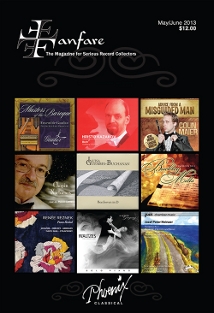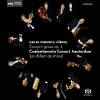Texte paru dans: / Appeared in:

Fanfare Magazine: 36:5 (05-06/2013)
Pour
s'abonner / Subscription information
Les abonnés à Fanfare Magazine ont accès aux archives du
magazine sur internet.
Subscribers to Fanfare Magazine have access to the archives of the magazine
on the net.
Challenge Classics
CC72570

Code-barres / Barcode: 0608917257021
Consultez toutes les évaluations recensées pour ce cd
~~~~ Reach all the evaluations located for this CD
The swiftness with which Handel turned out his op. 6 collection of 12 concerti grossi—roughly the month of October 1739—is sometimes considered with an emotion bordering on awe. It was a fine example of concentrated effort, but by no means unique in the composer’s experience, and certainly not limited to him alone. Telemann, Bach, and Vivaldi all composed as rapidly, as did many of their less-celebrated contemporaries. It was in part a matter of expediency. You needed to produce works regularly for the church where you were cantor; or for instruction in an orphanage that housed many illegitimate girls of noble or wealthy middle class families; or for the opera houses you were under contract to; or for a ruler who expected new works on a weekly, sometimes daily, basis. In a period that prized new entertainment, the nobles, guilds, and churchmen sometimes appear to have valued music as though it were so many yards of cloth, but as in these concerti grossi, we are fortunate that from time to time it was spun out of gold.
The scoring is emblematic of baroque practicality. Handel’s original version, as published, calls for “four Violins, a Tenor, a Violincello, with a Thorough-Bass for the Harpsichord.” However, the composer decided to include these concerti grossi as intermezzos during a series of 1739/1740 concerts featuring several of his odes and oratorios. He took advantage of the larger orchestra available at that time, and added parts for oboes and bassoons to the first, second, fifth, and sixth concertos. Given the popularity of the pieces, it’s hardly surprising recordings of both versions are common.
Jan Willem de Vriend and Combattimento Consort Amsterdam perform the strings-and-winds orchestration here. Theirs is also one of the larger ensembles to record this music recently. Leaving winds to one side, they feature nine to 10 violinists (depending on the work), three violists, two cellists, a double bassist, and a selection of continuo that includes organ, two harpsichords, and chittarone. They don’t use period instruments, and their performances are stylish, technically astute, and dynamically varied, with light ornamentation in the continuo. They are lively as well, while giving slow movements and Italianate legato their due. Vibrato is minimal, but the performers demonstrate that this is no impediment to producing attractive tone. Rhythms are tight, and strongly defined.
The competition is sizable, and as you might expect, hardly negligible. Among those that are similar in approach if not orchestration, Manze/Academy of Music (Harmonia Mundi 907228) has a thinner sound that makes much of the more contrapuntal movements. Benznosiuk/Avison Ensemble (Linn 362) performs along identical lines, but with a silky smooth instrumental sound that reminds me of 1950s British string orchestras. Compared to these, de Vriend/Combattimento Consort Amsterdam is sometimes spikier in its accenting, and occasionally faster, as in the final pair of movements to the Ninth Concerto Grosso. All three are excellent; and while other versions are equally worth considering, if you want plenty of energy and character in this extroverted music, these are the ones I’d single out as the most satisfactory.
If forced to choose, I’d opt for Benznosiuk should you be looking for strings only, and de Vriend if you want strings-and-winds. Both supply excitement, charm, and solid musicality, in heaping portions that might have even pleased that gourmand Handel himself.
Cliquez l'un ou l'autre
bouton pour découvrir bien d'autres critiques de CD
Click either button for many other reviews


